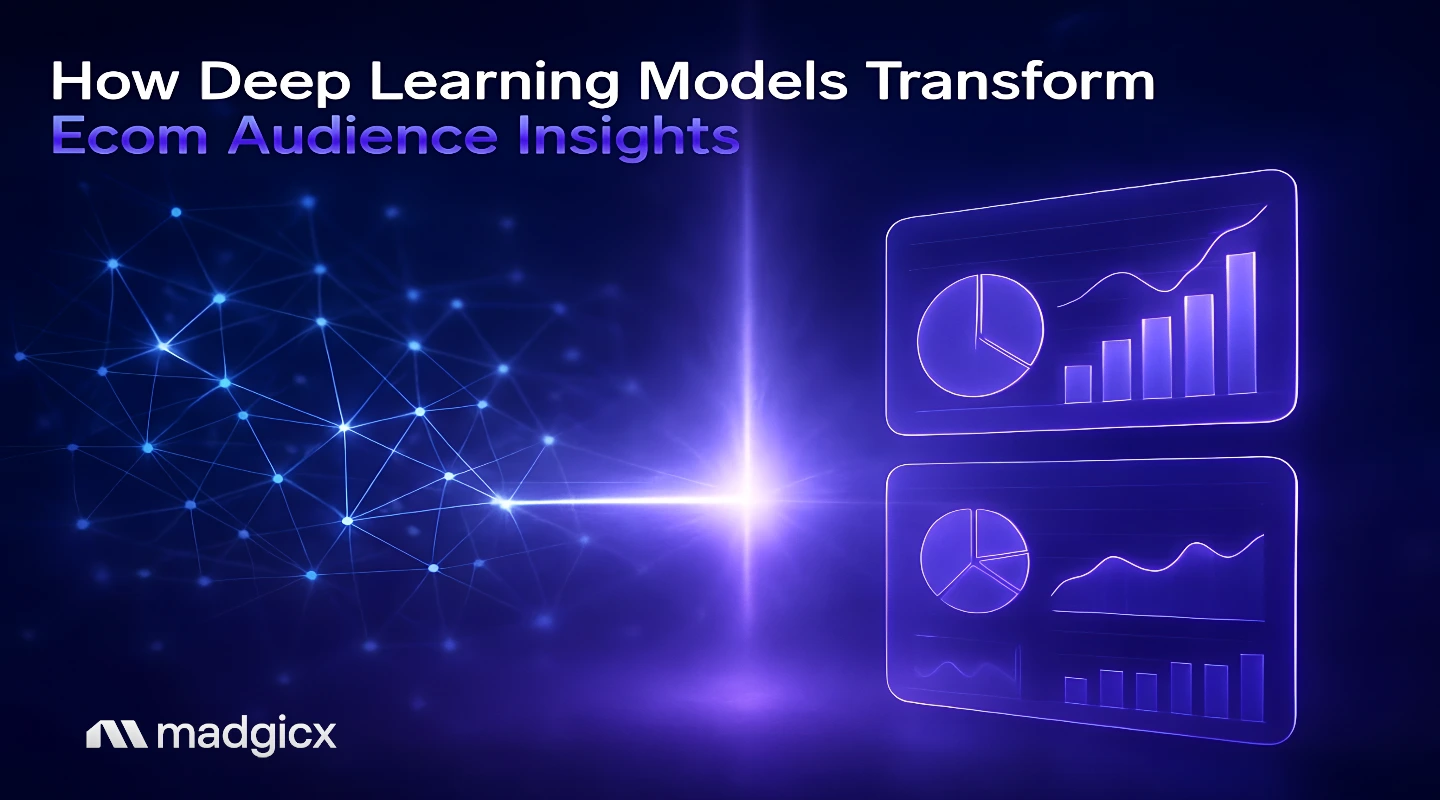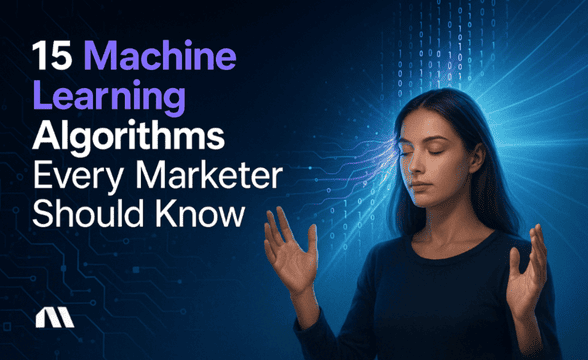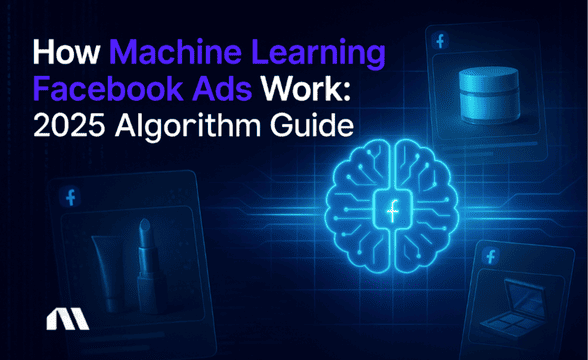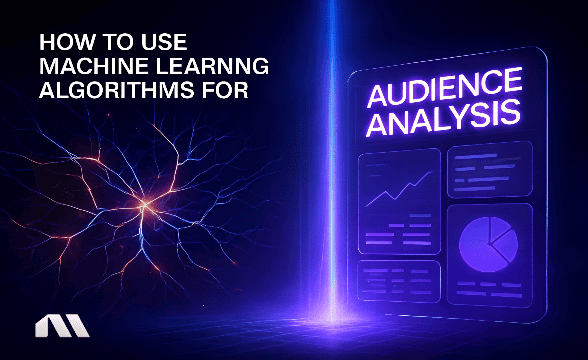Learn how deep learning models automate audience insights for e-commerce, saving hours weekly while boosting ROAS. Get an implementation guide and ROI metrics.
Every Monday morning, Sarah spends 4 hours analyzing customer data, segmenting audiences, and adjusting ad targeting for her Shopify store. By Wednesday, she's diving into Facebook Ads Manager again, trying to figure out why her lookalike audiences aren't converting.
By Friday, she's questioning whether her manual audience insights are even accurate—and her declining ROAS suggests they're not.
Sound familiar? You're not alone. The average e-commerce business owner spends over 15 hours weekly on manual audience research and targeting optimization. Meanwhile, your competitors who've embraced AI automation are scaling faster, spending less, and actually sleeping at night.
Here's the game-changer: Using deep learning models for audience insights transforms how e-commerce brands understand customers by analyzing behavioral patterns through neural networks, automating segmentation, and predicting purchase intent with 73-75% accuracy. These AI systems dramatically reduce the weekly time drain by automatically analyzing customer behavior patterns, predicting purchase intent, and segmenting audiences in real-time.
According to recent industry data, 78% of marketers now use neural networks for customer segmentation, and brands implementing these systems see up to 65% higher ROI with neural network-driven personalization compared to traditional targeting methods.
Ready to transform those Monday morning data sessions into automated insights that work while you sleep? Let's dive in.
What You'll Learn
By the end of this guide, you'll understand exactly how to implement using deep learning models for audience insights in your e-commerce business. We'll cover:
- How deep learning models work for e-commerce audience analysis (with simple explanations that won't make your head spin)
- A 5-step implementation process to automate your audience insights
- Real ROI metrics: potential for significant ROAS improvements, up to 30% CPA reduction, 15+ hours saved weekly
- Bonus: Madgicx platform walkthrough with setup guidance
What Are Deep Learning Models for Audience Insights?
Let's start with the basics. Deep learning models for audience insights are AI systems that use neural networks—computer systems inspired by the human brain—to analyze customer behavior patterns and predict future actions like purchases, churn, or product preferences.
Think of it like having a marketing expert who never sleeps, never gets tired, and can analyze thousands of customer interactions simultaneously. While you're focusing on product development or customer service, these AI systems are constantly learning from every click, purchase, and interaction on your site.
Here's what makes using deep learning models for audience insights different from traditional audience targeting:
Traditional Method: You manually create audiences based on demographics (women, ages 25-45, interested in fitness) and hope they convert.
Deep Learning Method: AI analyzes actual behavior patterns from your existing customers, identifies hidden correlations (like "customers who view product pages for 3+ minutes and add items to cart on mobile are 73% more likely to purchase within 48 hours"), and automatically creates audiences based on these predictive signals.
The accuracy difference is significant. While traditional demographic targeting typically achieves 65% accuracy in predicting customer behavior, deep learning models consistently achieve 73-75% accuracy in e-commerce applications.
For Shopify stores and DTC brands, this translates to finding your highest-value customers faster, reducing wasted ad spend on low-intent audiences, and scaling profitable campaigns with confidence. Instead of guessing which audiences might work, you're targeting based on actual behavioral predictions.
Pro Tip: Start by analyzing your top 20% of customers to identify behavioral patterns that deep learning models can replicate at scale. Look for common browsing patterns, purchase timing, and engagement sequences that predict high lifetime value.
Our guide to machine learning models for ad targeting explores how these systems integrate with your existing advertising workflows.
How Deep Learning Models Work for E-commerce Audience Insights (5 Steps)
Let's break down exactly how these AI systems transform raw customer data into profitable audience insights. Here's the step-by-step process for using deep learning models for audience insights:
Step 1: Data Collection - Gathering Customer Intelligence
The foundation starts with collecting comprehensive customer touchpoints across your entire sales funnel. This includes:
- Website behavior: Page views, time on site, scroll depth, product interactions
- Purchase history: Order values, frequency, seasonal patterns, product preferences
- Email engagement: Open rates, click-through rates, unsubscribe patterns
- Social media interactions: Comments, shares, ad engagement
- Customer service data: Support tickets, return patterns, satisfaction scores
The key difference from traditional analytics? Deep learning models don't just collect this data—they understand the relationships between different touchpoints. For example, they might discover that customers who engage with your email newsletters and spend 2+ minutes on product pages have a 340% higher lifetime value than average.
Step 2: Pattern Recognition - Identifying Hidden Buying Signals
This is where the magic happens. Neural networks excel at finding patterns humans would never notice. The AI analyzes millions of data points to identify subtle behavioral indicators that predict purchase intent.
Real examples from e-commerce brands using deep learning models for audience insights:
- Customers who view your "About Us" page are 45% more likely to make high-value purchases
- Mobile users who add items to cart between 7-9 PM have the highest conversion rates
- Customers who read product reviews for 30+ seconds show 67% higher retention rates
These insights become the foundation for creating highly targeted audience segments. Instead of broad categories like "women interested in skincare," you're targeting "high-intent mobile users with evening shopping patterns and review-reading behavior."
Step 3: Predictive Modeling - Forecasting Customer Actions
Now the AI builds predictive models to forecast future customer behavior. This includes:
Purchase Probability Scoring: Each website visitor gets a real-time score indicating their likelihood to purchase within specific timeframes (24 hours, 7 days, 30 days).
Customer Lifetime Value Prediction: The system predicts which customers will become high-value repeat buyers versus one-time purchasers.
Churn Risk Assessment: Identifying existing customers who are likely to stop purchasing, enabling proactive retention campaigns.
Product Affinity Modeling: Predicting which products individual customers are most likely to purchase next.
For implementation, platforms like Madgicx use these predictions to automatically adjust your Facebook advertising targeting in real-time. When the AI identifies a surge in high-intent visitors, it automatically alerts you to increases bids for similar audiences.
Pro Tip: Focus on purchase probability scoring first—it delivers the fastest ROI improvements by helping you identify and target visitors most likely to convert within 48 hours.
Step 4: Audience Segmentation - Creating Dynamic Customer Groups
Traditional audience segmentation is static—you create segments once and they rarely change. Using deep learning models for audience insights creates dynamic segments that evolve continuously based on new behavioral data.
Dynamic Segment Examples:
- "High-Intent Mobile Shoppers": Automatically includes users showing mobile purchase signals, updates hourly
- "At-Risk VIP Customers": Identifies valuable customers showing early churn signals, triggers retention campaigns
- "Lookalike Expansion Opportunities": Finds new prospects similar to your best customers, refreshes weekly
These segments automatically sync with your advertising platforms. When someone's behavior changes (like a casual browser becoming a high-intent shopper), they're instantly moved to the appropriate audience for optimized targeting.
Our machine learning models for audience segmentation guide provides deeper technical insights into this process.
Step 5: Real-time Optimization - Continuous Learning and Refinement
The final step is where deep learning models truly shine—continuous optimization without human intervention. The AI constantly:
- Monitors campaign performance across all segments and adjusts targeting parameters
- Tests new audience combinations based on emerging behavioral patterns
- Optimizes bid strategies for different customer lifetime value predictions
- Refines predictive models as new data becomes available
This creates a self-improving system. The more data it processes, the more accurate its predictions become. Brands typically see optimization improvements accelerate after the first 30 days as the AI accumulates sufficient behavioral data.
ROI Benefits of Using Deep Learning Models for Audience Insights
Let's talk numbers. The ROI from using deep learning models for audience insights isn't just theoretical—it's measurable and significant.
Time Savings: From 15+ Hours to 2 Hours Weekly
The most immediate benefit? Getting your time back. Manual audience research, segment creation, and targeting optimization typically consumes 15-20 hours weekly for growing e-commerce brands. With AI automation, this drops to 2-3 hours of strategic oversight.
What this means for you:
- No more Monday morning data deep-dives
- Dramatically reduce repetitive audience testing and optimization tasks
- Focus on high-level strategy instead of tactical execution
- Scale your advertising efforts without hiring additional team members
ROAS Improvement: Up to 65% Higher Returns (Based on Industry Data)
According to research on AI-driven personalization, brands using neural network-driven targeting can see up to 65% higher ROAS compared to traditional demographic targeting.
Why the improvement can be so significant:
- Precision targeting: Reach customers when they're most likely to purchase
- Reduced waste: Dramatically reduce spend on low-intent audiences
- Dynamic optimization: Continuous refinement improves performance over time
- Cross-platform insights: Apply learnings across Facebook and other channels
Cost Reduction: Up to 30% Lower Customer Acquisition Costs
Predictive audience selection can dramatically reduce your cost per acquisition. By targeting high-probability prospects instead of broad demographic groups, you're paying for quality traffic that actually converts.
Potential impact:
- If you're currently spending $10,000 monthly on Facebook ads with a $50 CPA, AI optimization could potentially reduce this to $35 CPA
- That's $3,000 in monthly savings or 85% more customers for the same budget
- Compound this over a year, and you're looking at $36,000 in additional profit or growth capital
Pro Tip: Start by implementing AI optimization on your highest-volume campaigns first. The data volume will help the AI learn faster and deliver more significant cost reductions.
Scalability: Handle 10x More Data Without Additional Staff
As your business grows, manual audience management becomes impossible. Deep learning models scale effortlessly, analyzing millions of customer interactions without requiring additional team members.
Consider this: Netflix reports that 80% of content watched is driven by their AI recommendation system. For e-commerce, this translates to AI-driven product recommendations and audience targeting that scales with your customer base.
The global AI in marketing market reached $96.8 billion in 2024, with e-commerce brands leading adoption specifically because of these scalability benefits.
Personalization at Scale: Netflix-Level Customer Experience
Using deep learning models for audience insights enables personalization that was previously only possible for tech giants. Your Shopify store can now deliver individualized experiences based on predictive customer insights.
Personalization applications:
- Dynamic ad creative: Show different product images based on predicted preferences
- Timing optimization: Deliver ads when individual customers are most likely to engage
- Cross-sell predictions: Recommend complementary products with high accuracy
- Retention campaigns: Proactively engage at-risk customers with personalized offers
Implementation with Madgicx Platform
Ready to start using deep learning models for audience insights in your e-commerce business? Here's how Madgicx makes AI-powered audience insights accessible without requiring a data science team.
Platform Overview: AI Marketer and Audience Intelligence
Madgicx's AI Marketer serves as your automated Meta ads optimization engine, using deep learning models to analyze your advertising accounts 24/7. The platform focuses specifically on e-commerce businesses, with built-in integrations for Shopify reporting and Facebook advertising.
Core capabilities include:
- Automated account audits: Daily analysis of campaign performance and optimization opportunities
- Predictive audience creation: AI-generated segments based on your customer behavior data
- Real-time bid optimization: Automatic adjustments based on conversion probability
- Cross-platform insights: Unified view of customer behavior across advertising channels
Setup Walkthrough: Getting Started in 4 Steps
Step 1: Connect Your Data Sources (Week 1)
- Link your Facebook Ads Manager account for campaign data
- Connect Shopify for customer purchase behavior
- Integrate Google Analytics for website interaction data
- Set up the Facebook pixel for enhanced tracking (Madgicx includes server-side tracking to address iOS data limitations)
Step 2: AI Training Period (Week 2-3)
During this phase, Madgicx's deep learning models analyze your historical data to identify patterns and create baseline predictions. You'll see initial insights within 48 hours, but optimal performance requires 2-3 weeks of data processing.
Step 3: Audience Segment Creation (Week 3-4)
The AI automatically creates dynamic audience segments based on behavioral patterns:
- High-value customer lookalikes
- Purchase-intent prospects
- Re-engagement opportunities
- Cross-sell candidates
Step 4: Campaign Optimization Activation (Week 4+)
Once trained, the AI begins real-time optimization:
- Automatic bid adjustments based on audience quality
- Budget reallocation to highest-performing segments
- New audience testing and expansion
- Performance monitoring and recommendations
Integration Requirements and Best Practices
Minimum Data Requirements:
- 1,000+ website visitors monthly for basic insights
- 100+ conversions in the past 30 days for predictive modeling
- Facebook pixel installed with standard e-commerce events
- At least 30 days of historical advertising data
Best Practices for Optimal Results:
- Ensure clean, consistent conversion tracking across all platforms
- Maintain updated product catalogs in Facebook Business Manager
- Use UTM parameters for comprehensive attribution tracking
- Set up enhanced e-commerce tracking in Google Analytics
For technical implementation details, our guide on machine learning models for customer acquisition provides step-by-step setup instructions.
Pro Tip: Before connecting your accounts, audit your current tracking setup. Clean data from day one ensures faster AI training and more accurate predictions.
Timeline: What to Expect Week by Week
- Week 1: Data integration and initial setup
- Week 2: AI model training begins, first insights available
- Week 3: Audience segments created, initial optimization recommendations
- Week 4: Full automation activated, performance improvements visible
- Week 5-8: Continuous optimization, potential ROAS improvements accelerate
- Week 9+: Mature AI performance, potential for significant ongoing improvements
E-commerce Success Stories
Let's look at real-world results from businesses that have implemented using deep learning models for audience insights.
Case Study 1: Midwest Bank Centre - 8% Conversion Rate with AI Segmentation
Challenge: This financial services company struggled with broad demographic targeting that yielded poor conversion rates and high acquisition costs.
Solution: Implemented AI-driven behavioral segmentation to identify high-intent prospects based on website interaction patterns and financial product research behavior.
Results:
- 8% conversion rate on targeted campaigns (vs. 2.1% industry average)
- $5 million in new deposits generated within 6 months
- 67% reduction in cost per qualified lead
- 3x improvement in customer lifetime value from AI-targeted acquisitions
Key Insight: The AI discovered that prospects who spent time reading educational content about specific financial products were 340% more likely to convert within 30 days.
Case Study 2: Service Seeking - 33% Conversion Rate with Real-time Optimization
Challenge: This service marketplace needed to connect customers with local service providers while maintaining high conversion rates across diverse geographic markets.
Solution: Deployed deep learning models to analyze user behavior patterns, service preferences, and geographic factors for real-time audience optimization.
Results:
- 33% conversion rate on optimized campaigns
- 45% reduction in customer acquisition costs
- 2.3x increase in customer lifetime value
- Real-time audience refinement based on service demand patterns
Key Insight: AI identified that users who viewed multiple service provider profiles within 10 minutes had the highest conversion probability, enabling dynamic retargeting campaigns.
Case Study 3: RetailPro - 15% Retention Increase with Behavioral Analysis
Challenge: This e-commerce retailer faced increasing customer churn and needed to identify at-risk customers before they stopped purchasing.
Solution: Implemented predictive churn modeling using deep learning to analyze purchase patterns, engagement metrics, and seasonal behavior.
Results:
- 15% increase in customer retention through proactive campaigns
- 10% overall sales growth from improved customer lifetime value
- $2.3 million additional revenue from retention improvements
- Automated early warning system for at-risk VIP customers
Key Insight: The AI discovered that customers who skipped their typical seasonal purchase window had a 78% churn probability within 90 days, enabling targeted retention campaigns.
These success stories demonstrate the practical impact of using deep learning models for audience insights across different business models and industries. The common thread? Businesses that embrace AI-powered audience insights see measurable improvements in conversion rates, customer acquisition costs, and overall profitability.
For more insights on implementing these strategies, check out our comprehensive guide on advanced machine learning models for customer insights.
Common Challenges & Solutions
Implementing using deep learning models for audience insights isn't without challenges. Here are the most common concerns e-commerce business owners face and practical solutions.
"Black Box" Concerns: Understanding AI Decisions
The Challenge: Many business owners worry about AI making decisions they can't understand or explain.
The Solution: Modern platforms like Madgicx provide interpretable Meta ad insights alongside AI recommendations. Instead of just saying "increase bids for this audience," the system explains: "This audience shows 73% higher purchase intent based on recent browsing behavior and seasonal patterns."
What you get:
- Clear explanations for each optimization recommendation
- Performance data showing why specific audiences are prioritized
- Ability to override AI decisions when business context requires it
- Transparent reporting on which behavioral signals drive predictions
Data Quality Issues: Garbage In, Garbage Out
The Challenge: AI models are only as good as the data they analyze. Poor tracking setup leads to inaccurate predictions.
The Solution: Start with a comprehensive data audit and cleanup process.
Minimum requirements:
- Facebook pixel firing correctly on all key pages
- Consistent conversion tracking across platforms
- Clean customer data without duplicates or errors
- At least 30 days of reliable historical data
Expertise Gaps: No Data Science Team Required
The Challenge: Many e-commerce businesses assume they need data scientists or technical experts to implement AI.
The Solution: Choose turnkey platforms designed specifically for non-technical users.
What to look for:
- Pre-built e-commerce templates and workflows
- Automatic integration with existing tools (Shopify, Facebook, Google)
- Clear setup guides and onboarding support
- No coding or technical configuration required
Madgicx specifically addresses this by providing an advertising platform built for e-commerce businesses, not generic AI tools that require technical expertise.
ROI Measurement: Proving AI Value
The Challenge: Measuring the incremental impact of AI optimization versus other factors affecting performance.
The Solution: Implement a clear KPI framework with baseline measurements.
Key metrics to track:
- ROAS improvement: Compare pre-AI vs. post-AI performance
- Time savings: Document hours spent on manual optimization
- CPA reduction: Track cost per acquisition improvements
- Audience quality: Monitor conversion rates by audience segment
- Scale efficiency: Measure growth in ad spend without proportional team growth
Recommended approach: Run AI optimization on 70% of your campaigns while maintaining 30% as a control group for accurate comparison.
For detailed measurement strategies, our guide on conversion prediction models provides comprehensive KPI frameworks.
Frequently Asked Questions
How much data do I need to start using deep learning models for audience insights?
You need a minimum of 1,000 monthly website visitors and 100 conversions in the past 30 days for basic AI insights. However, optimal performance requires 5,000+ monthly visitors and 500+ conversions for robust predictive modeling.
If you're below these thresholds, start with basic machine learning features and scale to deep learning as your data volume grows.
What's the difference between deep learning and basic Facebook targeting?
Facebook's basic targeting uses demographic and interest data (age, location, interests) to find audiences. Using deep learning models for audience insights analyzes actual behavioral patterns from your customers to predict who's most likely to purchase.
For example, instead of targeting "women aged 25-45 interested in fitness," deep learning might target "users who view product pages for 3+ minutes, add items to cart on mobile, and typically purchase within 48 hours." The behavioral approach typically achieves 73-75% accuracy vs. 65% for demographic targeting.
How long before I see ROI improvements from AI audience targeting?
Initial improvements typically appear within 2-3 weeks as the AI learns your customer patterns. Potential ROI improvements usually become visible after 4-6 weeks of optimization.
The timeline depends on your data volume—businesses with higher traffic and conversion volumes see faster results. Peak performance is typically achieved after 8-12 weeks when the AI has sufficient data for advanced predictive modeling.
Can deep learning models work with my existing marketing stack?
Yes, most modern AI platforms integrate with standard e-commerce tools. Madgicx connects with Facebook Ads Manager, Google Ads, Shopify, Google Analytics, and email platforms like Klaviyo.
The key is ensuring clean data flow between platforms. You don't need to replace your existing tools—AI optimization enhances what you're already using.
What if I don't have technical expertise to implement AI models?
Choose platforms designed for non-technical users. Madgicx, for example, provides automated setup, pre-built e-commerce templates, and requires no coding knowledge.
The platform handles technical complexity while providing clear, actionable recommendations. Most e-commerce business owners can complete setup within a week using guided onboarding processes.
Start Using Deep Learning Models for Audience Insights Today
We've covered a lot of ground, but here's what matters most: Using deep learning models for audience insights isn't just a nice-to-have anymore—it's becoming essential for competitive e-commerce advertising.
Key takeaways to remember:
- Deep learning models automate audience insights, saving you 15+ hours weekly on manual optimization
- Brands implementing these systems can see significant ROAS improvements and CPA reductions
- Implementation takes 2-4 weeks with turnkey platforms like Madgicx
- You don't need technical expertise—modern platforms handle the complexity
Your next steps:
- Audit your current audience data quality - Ensure your Facebook pixel and conversion tracking are working correctly
- Choose a platform with built-in deep learning capabilities - Look for e-commerce-specific features and easy integration
- Start with audience segmentation for your best-selling products - Focus on high-volume, high-value product categories first
- Set up KPI tracking - Establish baseline metrics for ROAS, CPA, and time spent on optimization
- Scale to additional use cases - Expand to retention campaigns, cross-sell optimization, and new customer acquisition after proving initial ROI
Pro Tip: Don't try to implement everything at once. Start with one high-impact use case (like purchase intent scoring for your top product category) and expand from there.
The e-commerce landscape is evolving rapidly. While you're spending hours manually analyzing customer data and adjusting targeting, your AI-powered competitors are scaling faster, spending smarter, and capturing market share.
The question isn't whether AI will transform e-commerce advertising—it already has. The question is whether you'll be leading that transformation or playing catch-up.
Transform your manual audience research into automated insights that work 24/7. Madgicx's deep learning models analyze Meta customer behavior patterns and optimize targeting in real-time, so you can focus on growing your business instead of managing ads.
Digital copywriter with a passion for sculpting words that resonate in a digital age.







.avif)







